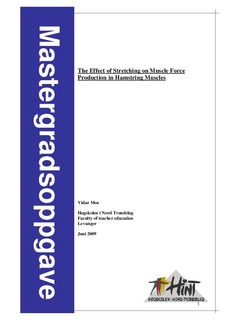| dc.description.abstract | Formålet med dette studiet var å undersøke de akutte effektene som proprioceptive
neuromuscular facilitation stretching (PNF) har på maximal voluntary contraction (MVC),
rate of force development (RFD), power (P) og time to peak power (TPP) både i en isometrisk
og en dynamisk kontraksjon av hamstring.
10 mannlige kickboksere deltok i studiet som bestod av to testdager. Forsøkspersonene
gjennomførte før hver testdag en oppvarming, bestående av 10 minutter løping på tredemølle
med et intensitetsnivå på 60% av deres HFmax. Etter denne oppvarmingen ble hver enkelt
forsøksperson testet i de to styrkeøvelsene, enten med eller uten stretching i forkant.
Halvparten av utvalget startet første testdag med PNF før de fullførte styrkeøvelsene, mens
det andre utvalget testet uten PNF. Testprosedyren (med og uten PNF) for de to utvalgene ble
byttet om på andre testdag. Det var tilfeldig hvem som startet med stretching før
gjennomføringen av styrkeøvelsene. Den dagen hvor det ikke ble foretatt noen stretching, ble
brukt som en kontrollbetingelse for den neste dagen med stretching.
Resultatene viste en signifikant nedgang i MVC og en signifikant forbedring i TPF på den
isometriske øvelsen, men ingen signifikant endring i den dynamiske styrkeøvelsen på
variablene MVC, TPF, P og TPP.
Det ble derfor konkludert med at PNF stretching har en negativ effekt på styrkeprestasjonen
målt som MVC i isometrisk styrke, men at det er en trend at PNF har en positiv effekt på både
isometrisk og dynamisk TPF. The purpose of this study was to explore the acute effect of proprioceptive neuromuscular
facilitation stretching (PNF-S) on maximal voluntary contraction (MVC), rate of force
development (RFD) and power in both isometric and dynamic contractions of hamstring
(knee flexion).
10 volunteer male kickboxers participated in the experiment. The subjects underwent two
days of testing, and randomly the subjects were tested with or without stretching the first or
the second day of testing. The day without PNF-S was used as a control condition for the day
with PNF-S.
Each experimental condition conducted of a 10min warm up on at treadmill at approximately
60% of the subjects HFmax. Immediately after warm up the day without stretching the
dependent variables in both the isometric and dynamic contractions of the hamstrings were
tested. After warm up the other day with PNF-S the subjects underwent a controlled PNF-S
sequence of the hamstring that was immediately followed by a test of the dependent variables.
The result shows a significant decrease in MVC and a significant improvement in RFD in the
isometric contraction, but no significant changes in the dynamic condition.
It is concluded that PNF has an acute negative effect on muscle force production measured as
MVC in the isometric contraction, but ther is a trend that PNF has a positive effect on both
isometric and dynamic TPF. | en |
